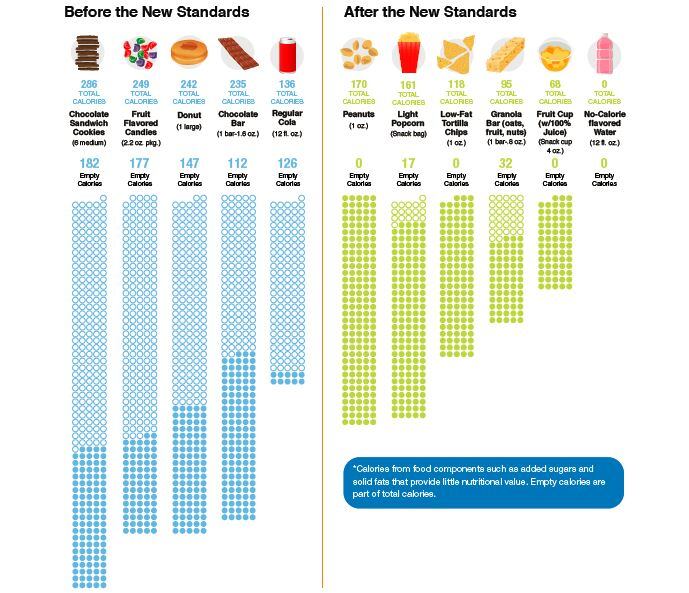This school year marks the first that the Healthy Hunger-Free Kids Act of 2010 is fully implemented. The heightened nutrition standards on food sold in schools, established by the US Department of Agriculture, have been gradually phased in since 2012.
To date more than 90% of schools have implemented the school meal nutrition standards, meaning some 32 million public school children on the National School Lunch Program are getting more fruits, vegetables and whole grains, and less sodium and saturated fat on their breakfast and lunch trays. But beyond that, vending machines and school stores nationwide have traded candy, donuts and sports drinks for healthier snacks and drinks such as nuts, whole grain granola bars and flavored sparkling water.
But a veritable food fight over the heightened nutrition standards erupted in May, when a US House of Representatives panel announced a plan offering school districts a one-year waiver to opt out of the heightened nutrition standards if they can demonstrate "a net loss from operating a food-service program for a period of at least six months that begins on or after July 1, 2013. The contentious waiver proposal came via language included in the Republican-led House Agriculture Appropriations subcommittee's budget proposal on May 19 and was passed by the House Appropriations Committee on May 29. Its status is on hold until after the fall elections.
Supporters of the waivers—which include the School Nutrition Association and the National School Boards Association—argue that school meal programs are grappling with declining student participation, increased waste (to the tune of $3.8 million worth of produce each day), increased costs and overly prescriptive requirements that stifle menu creativity and reduce the appeal of healthy school meals.
Opponents, ranging from the Obama administration to the National Education Association and an ad hoc group of 100 children’s health groups, argue that the setback could dampen efforts to combat the growing threat of childhood obesity. (Indeed, analysis of recent data from the National Health and Nutrition Examination Survey found that 17.9% of children aged 2 to 19 in the US were obese in 2011-2012.)
Consumer advocacy groups and public health officials worry that school food manufacturers will see the reauthorization of child nutrition legislation in 2015 as an opportunity to roll back progress.
'Micromanagement bordering on absurdity'
“Of course it’s a threat and an outrageous one,” Marion Nestle, PhD, Paulette Goddard professor of nutrition, food studies and public health at New York University, told FoodNavigator-USA. “Shouldn’t kids’ health be the number one priority? And take precedence over corporate interests and even those of the School Nutrition Association leadership? Congress has already intervened on behalf of corporate and agribusiness interests by overturning the USDA’s research-based standards for pizza and potatoes.
“This is micromanagement to the point of absurdity. Some schools are having trouble implementing the new standards but USDA says it is willing to work with such schools. It would be better for them to ask for help than to try to get Congress to intervene.”
USDA Secretary Tom Vilsack has said that the USDA will work with districts to ease implementation through grants for equipment and flexibility where necessary.

The road to the Healthy, Hunger-Free Kids Act
Slow federal-level progress throughout the first 10 years of the 2000s sent health advocates tackling school nutrition standards at the state, city and school district level. In 2006, the soda industry gave the movement momentum when it agreed to pull full-calorie sodas from schools. That same year, federal legislation gained bipartisan support but failed to advance.
A breakthrough came with the reauthorization of the Child Nutrition Act in 2009, which increased investment in childhood nutrition programs and set the stage for Congress’ passage of the Healthy, Hunger-Free Kids Act in 2010, which was supported by 1,350 health, education, and anti-hunger groups along with several big food and beverage companies. The act also significantly increased funding for the school lunch program, made it easier for qualified children to receive free school meals and extended after-school meals to at-risk children.
Prospects for that legislation were further bolstered by the launch of First Lady Michelle Obama’s Let’s Move campaign to end childhood obesity, which pushed school nutrition into the limelight.
“[School meals] comprise a large part of the calories of many school-age children, and schools set an example for what’s normal and appropriate for kids to be eating,” Dr. Nestle noted. “Research is already showing that kids in states with stricter school nutrition standards eat more healthfully and are less obese than kids in schools with looser standards. Regardless of cause, that suggests that making school meals healthier is a good thing to do.”
